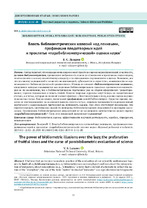Власть библиометрических иллюзий над ленивыми, профанация плодотворных идей и проклятье «парабиблиометрической» оценки науки
Another Title
The power of bibliometric illusions over the lazy, the profanation of fruitful ideas and the curse of parabibliometric evaluation of science
Bibliographic entry
Лазарев, В. С. Власть библиометрических иллюзий над ленивыми, профанация плодотворных идей и проклятье «парабиблиометрической» оценки науки / В. С. Лазарев // Научный редактор и издатель. – 2019. – Т. 4, №1–2. – С. 12-20. https://doi.org/10.24069/2542-0267-2019-1-2-12-20
Abstract
Автор полагает, что извращения в современной практике оценки науки происходят, в частности, по вине библиометристов, проявивших небрежность и лень по отношению к трактовкам индикаторов, по отношению к самому понятийному аппарату и по отношению к терминологии в целом. Чиновник, все это по-своему замечающий и ни во что не вникающий, «убеждается» в «простоте», «очевидности» и «од
нозначности» библиометрической «диагностики». Отсюда возникают «библиометрические иллюзии», следствием которых оказываются как порочные библиометрические практики применения индикаторов не по назначению, так и библиометрические подтасовки уже на стадии оформления / редактирования / оценки подаваемых в печать статей. Многие мировые журналы ищут теперь не «качественные статьи», а «статьи, которые не понизят импакт-фактор» – безотносительно к тому, какова оценка научного качества статьи. Как результат, происходит профанация самой библиометрии. Средство оценки, никогда не претендовавшее на исключительность своего статуса, невольно превращается в репрессивный инструмент с максимальной претензией на истинность оценок. При этом отсутствует понимание, что спрогнозировать «достижение» какой-то величины библиометрических показателей в принципе невозможно. Применение библиометрических показателей не по назначению автоматически делает оценку «парабиблиометрической»2. Сила этих тенденций напоминает проклятье!
Abstract in another language
I believe that perversion in modern practice of the evaluation of our scientific performance happen by fault of us, bibliometricians, too, as bibliometricians were negligent and laze about the interpretation of indicators, about conceptions (e.g., “altmetrics,” a term that is devoid of attempts to reflect the nature of the “discipline”; the use of the term “metric” instead of “indicator” as a sign of overvalued diagnostic ambitions) and about terminology (e.g., the use of the terms “value” and “quality”, “usefulness” and “influence” as full synonyms). A bureaucrat–noticing all this in his own way and going into no details – comes to believe in “simplicity”, “obviousness” and “unicity” of bibliometric “diagnostics”. The сonsequence is “bibliometric illusions”. E.g. 1) “everything can be measured with one number!” (The result is Hirschmania at the level of planetary psychosis. The Hirsch index acquired the status of a sacred cow among bureaucrats and of a Procrustean bed among scientists – at the same time.); 2) “the conclusions are obvious” (E.g. if the journal is not sufficiently cited, “it is necessary to oblige its authors to give appropriate references in each article”. And if the average good article of the natural science profile has at least 10 references, then this “should be a mandatory minimum norm”. Some of the world’s journals arbitrarily intervene in the structure of citations in the articles they receive! But forcedly falsified references are neither a means of information coupling, nor a bibliometric indicator.); 3) “if the bibliometric indicators adequately reflect the quality of the scientific product, it is necessary to oblige scientists to produce not a scientific product, but the corresponding values of indicators” (Many world’s journals are now looking not for “quality articles”, but for “articles that will not lower our impact factor”. Some methodological features might be mistaken for a consequence of “specific Belarusian (Ukrainian, etc.) conditions”, which “is fraught with the fall of our impact factor.”) As a result, there occurs a profanation of bibliometrics itself. This means of evaluation (which has never claimed the exclusivity of its status!) unwittingly turns into a repressive tool with a maximum claim to the truth of the estimates. At the same time, there is no understanding that it is impossible in principle to predict the reach of a certain value of bibliometric indicators. The use of bibliometric indicators not for their intended purposes automatically makes the evaluation parabibliometric. The power of these trends resembles a curse!

